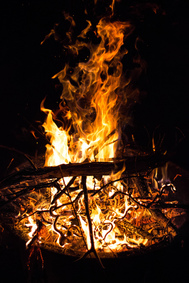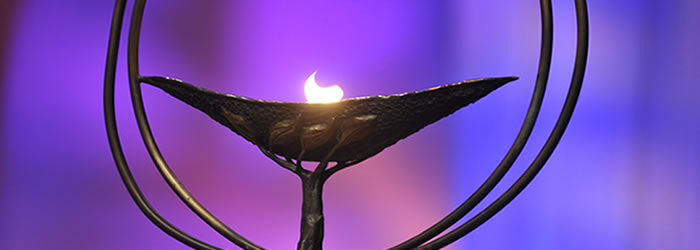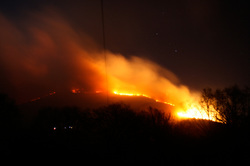It’s also true that to an extent is a good and essential thing. We need fire in some form in order to stay warm and (unless we raw foodies) to prepare some of our food. In today’s world we need to move around and sometimes that requires some internal combustion. Even the forests need fires now and again - some seeds only germinate when exposed to heat and so fire can renew a forest. So yes, we need fire in our lives and our world but we need it in a balanced way - just enough, not too much.
In earth-centered traditions fire is the element of passion, transformation, and change. This is what fire symbolizes for me spiritually. We need some passion, some transformation and some change but we also need stability and continuity. And so today we hold in our hearts the intention of warmth, of change and of transformation, of nourishment and movement in our lives.

It can take a while to get married and even longer to stay married. The first sparks of passion take some time and attending in order to be become the home fires of a marriage. Even then there needs to be some common ground in terms of beliefs and values to lay the structure for this sort of fire.
You don’t want things to burn too hot because then the relationship can burn itself out. You don’t want to dampen things too much or the spark will go out. You need to find the right balance of spark and fuel to make the fire of commitment into one that provides warmth and comfort to the partners and to their home.
A second reason to talk about commitment right nowthat this year is the fifty-fifth anniversary of the consolidation of Unitarianism and Universalism into Unitarian Universalism. This consolidation also took some time to come into being. The first sparks were there in the late 1800s - a lot of mutual attraction. Some members and ministers identified as both Unitarian and Universalist a long time before the two came together.
This makes sense because the two religions share a number of common beliefs and values - both rejected the notion of original sin - both refused to have a creed or statement of belief and for both that kept the belief system open and growing. Both had liberal social commitments as well as religious beliefs. It made sense.
Talk of consolidation began in the late 1800s. Early attempts failed because the leadership tried to impose it top-down. People in both religions have always been independent and have distrusted authority so that didn’t fly.
Eventually groups within the religions decided to work together anyway. Musicians cooperated to put together a hymnal, Hymns of the Spirit, in 1937. This added some fuel to the fire. The youth groups merged to form Liberal Religious Youth, in 1953. Some who grew up Unitarian Universalist remember LRY and know that had a fiery sort of feel to it.
When the youth advocated that the parent organizations come together and “make it official,” a joint commission studied how the consolidation might work. They came up with a plan, and asked the congregations to vote on it (having learned their lesson about not imposing their will). This time it took. Most congregations voted in favor of consolidation. Some came around later.
The two religions had coming beliefs, values, and commitments and a spark of mutual interest. They used these to create a new religion called Unitarian Universalism. If you think I am stretching this relationship metaphor too far, consider this - at the worship service for the consolidation, after they remembered their separate Unitarian and Universalist religious ancestors, the congregation said….
Seeing that we are compassed round
by so great a cloud of witnesses,
the great of past and present
and all the humble heroes
who worked and sacrificed beside them, …
let us now, in our own day,
lay aside every weight of selfishness and fear
and take up with faith and joy
the urgent tasks to which this historic hour
has summoned us.
Let us together build the free and
universal church of tomorrow.
Stirring stuff, huh? They went on to say....
We, Unitarians and Universalists,
children of the Judeo-Christian heritage,
inheritors of the wisdom of the universal prophets,
eager to experience the insights
of the great faiths of the world,
open to all Sources of inspiration ancient and Modern,
determined to explore the boundless ocean of truth
and welcoming into fellowship all …
of whatever background of faith,
here together on this night of Consolidation,
conscious of the presence of the past, and of our urgent tasks,
dedicate ourselves anew to the free and universal fellowship
of all (hu)mankind that is the church to be.
We declare our allegiance
to the new Unitarian Universalist Association,
and pledge our lives, our fortunes and our faith
to its high purposes and sure upbuilding.
I don’t know about you, but that sure sounds like a vow to me, a commitment. So that covers two reasons to talk about commitment now Beltane, a traditional holy day of commitment, and celebrating the 55th anniversary of the consolidation.

Making ourselves part of the community starts out small, usually, with the weekly offering, singing in the choir, helping out with coffee hour, and so forth. Over time we decided to pledge more financially and may take on greater commitments of time and talent as well. This is all part of growing as stewards of this beloved community.
If you’re new to this church or to religion, period, you may have no idea how much to give. What’s appropriate? In all aspects, time, talent, and treasure you need to find the right balance, just as you would in any relationship. Too much and you risk burning yourself out and/or feeling resentful.
Some people’s identity in relationship to the church is so centered on giving that think they have to give in order to be here. So they burn themselves out and then drop away because they don’t know any other way to be in relationship with the congregation. If their circumstances change and they can no longer give in the same ways, they may stop attending and lose the support of this community when they need it most.
It is possible and sometimes necessary to allow others to give and to allow ourselves to receive. I learned, as a lay leader, that part of leadership is knowing when you’re doing too much and stepping back to allow someone else to step up and grow in their commitment. It’s okay to take a break, and if you cannot afford to give financially right now that’s okay.
So that’s the side of giving too much - the other side is giving less than you really can. It’s obvious that this affects the rest of our members who have to give to keep things going. Giving too much and giving too little are related. It is good to learn the practice of generosity and of giving from your time and talents. It is part of the process of spiritual growth that we hope to nurture here - it’s one of our principles - acceptance of one another and encouragement to spiritual growth. I encourage you to grow in the way of giving just the right amount.
Because we believe in freedom of conscience here, I can’t tell you what that amount is (though this sermon is often called the sermon on the amount). I can tell you how I handle it. I aspire to give ten percent of my adjusted gross income to charity every year. I give at least half of that to Unitarian Universalism - either to this congregation or to various other funds. As I have received inheritance money I have been giving 10% of that away to various charities, as well.
Last year I had only my income from this part-time position for the first half of the year, so I pledged around 4% of my income, about $12,000, to the church I serve. That is about average there - some give more and some give less. Last summer I landed another part-time position as a hospice chaplain and so have given more than my pledge.
This year I am giving a bit more to some other charities but even at 3% of my adjusted gross income, my pledge here will be quite a bit more than what it was last year. If you’re new to a congregation, you may also wonder how you pay your pledge. You can pay it any way you want – quarterly or whatever. I like to pay it monthly like any of my other financial commitments.
To me giving is a spiritual practice – it lives my values, puts my money where my heart is. I like being able to be that generous. There were times when I was not able to give so much. When I was living below the poverty level, I gave what I could financially and then gave in other ways – showing up for worship, volunteering, and so forth. There are many ways to give.
So far I’ve talked mostly about our commitment to our congregations - but this is a relationship. Congregations are also committed to all of us and to the wider community. After all, people do not exist in order to serve institutions, institutions exist in order to serve people.
This church serves us by providing staff who lead worship and religious education, who keep the place clean and who see to the administration. That’s a big expense but I think we get good value for our money because our staff is dedicated and talented. Or course volunteer time and talent also makes it possible for our institution to serve us - and we serve the wider community through the food pantry, social justice programs, and so on.
With all due respect to JFK, I ask you to consider not only what you can do for this church, but also what our church can do for you. What sort of church do you need this church to be? How can it better serve you? How might it better serve others, such as its future members? Think about that, and talk about it with me or with one of our elected leaders. In what ways can this church help to keep the divine spark within you and in our world glowing and growing?
We celebrate the transforming fire of commitment between our church and each of us, between this church and the wider world. We consider the best ways go give of ourselves to the church, and the best ways our church can give to us and the world around us. We consider the ways we already give to the church, and ways the church already gives to us.
We give and we receive, and that keeps the fire of commitment burning. It gives warmth to our lives, of course, but it can also transform our lives - and in so doing the church itself transforms, and transforms the world around it. We give in order to receive, and we receive in order that we may give. May we move with our congregations in mutual commitment that will sustain the transforming warmth of this church and this faith to build the free and universal church of tomorrow. So may it be. Amen and Blessed Be.

 RSS Feed
RSS Feed